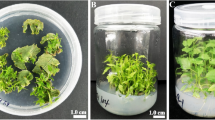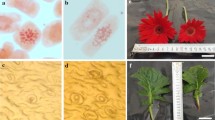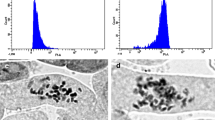Abstract
Eastern gamagrass, (Tripsacum dactyloides L.) is a perennial, warm-season grass that is being developed as a forage plant. Shoots were derived from callus initiated from immature embryos and immature inflorescences of diploid (2n=2x=36) gynomonoecious eastern gamagrass. These shoots were induced to microtiller in the presence of 3 mg/l benzyladenine. Amiprophosmethyl (10, 15, or 20 μm) was applied to 27 microtillers for 3–5 days to induce chromosome doubling. All 14 surviving plants were tetraploid, (2n=4x=72), as determined by flow cytometry or chromosome counts. These plants were morphologically normal and produced seed. Test crosses were made with a known diploid. Flow cytometry and chromosome counts showed that the progeny were triploid, proving that the induced tetraploids reproduce sexually.
Similar content being viewed by others
Author information
Authors and Affiliations
Additional information
Received: 12 February 1997 / Revision received: 18 February 1998 / Accepted: 13 March 1998
Rights and permissions
About this article
Cite this article
Salon, P., Earle, E. Chromosome doubling and mode of reproduction of induced tetraploids of eastern gamagrass (Tripsacum dactyloides L.). Plant Cell Reports 17, 881–885 (1998). https://doi.org/10.1007/s002990050502
Issue Date:
DOI: https://doi.org/10.1007/s002990050502




